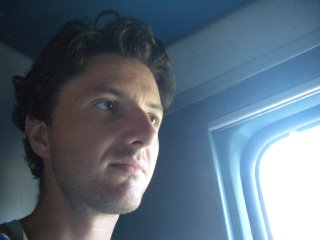 More south now did we drive to Savatthi, where the mobile portion of our yatra would finish. Savatthi is where the Buddha spent the last 20 years of his life, and is an extremely important place. Bhanteji told us that every Samasan-Buddha, past and present, spends a good deal of his life in Savatthi, and that sitting one course here would be like sitting a ten day course in Igatpuri-- thus every day here for us would be like one ten day course elsewhere. It was here where Anathapindika invited the Buddha to come and teach Dhamma. He wanted to buy the land from Prince Jeta, who did not wish to sell, and as a way of sending him off, suggested that the only price he'd settle on is to spread
More south now did we drive to Savatthi, where the mobile portion of our yatra would finish. Savatthi is where the Buddha spent the last 20 years of his life, and is an extremely important place. Bhanteji told us that every Samasan-Buddha, past and present, spends a good deal of his life in Savatthi, and that sitting one course here would be like sitting a ten day course in Igatpuri-- thus every day here for us would be like one ten day course elsewhere. It was here where Anathapindika invited the Buddha to come and teach Dhamma. He wanted to buy the land from Prince Jeta, who did not wish to sell, and as a way of sending him off, suggested that the only price he'd settle on is to spread 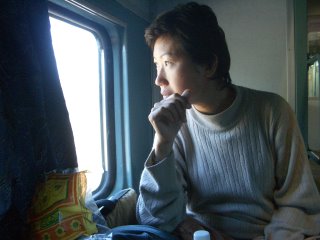 gold sovereigns over the land. Anathapindika agreed, and it became known as Jetavana. The Buddha delivered more sermons here than in any other place, and it was estimated that "countless" arahants have lived here... possibly up to 50 million (!)... countless! The land Jetavana operates today is a small fraction and replica of the vast areas it used to possess, but even the replicas date back, I believe, to the Ashokan era (about 300 years after Buddha). And although the park may be small, every inch of this area is filled with splended occurences and powerful vibrations... here is a shot below of one of our favorite places to hold the group meditations...
gold sovereigns over the land. Anathapindika agreed, and it became known as Jetavana. The Buddha delivered more sermons here than in any other place, and it was estimated that "countless" arahants have lived here... possibly up to 50 million (!)... countless! The land Jetavana operates today is a small fraction and replica of the vast areas it used to possess, but even the replicas date back, I believe, to the Ashokan era (about 300 years after Buddha). And although the park may be small, every inch of this area is filled with splended occurences and powerful vibrations... here is a shot below of one of our favorite places to hold the group meditations...
 We arrived late at night, and stayed at the Korean monastery (see photo to the right). Like so much of what we had been seeing, the grounds here were enormous and still only half completed. Because a hundred or so Sri Lankan pilgrims were here, we were confined to only a couple of rooms the first night. Bhanteji had met the head abbot the year before. Meditating every day in Jetavana, one Korean nun was very impressed. Most people come to pay homage in their own way and go on; few people pay homage by trying to walk the path. She came up to him and, like most people believing him to be Sri Lankan, started complaining about the lost Dhamma of India-- "Indian dogs, Indian kids, Indian monkeys-- beggars, all of them". When she found out he was indeed Indian, she became more excited-- a re
We arrived late at night, and stayed at the Korean monastery (see photo to the right). Like so much of what we had been seeing, the grounds here were enormous and still only half completed. Because a hundred or so Sri Lankan pilgrims were here, we were confined to only a couple of rooms the first night. Bhanteji had met the head abbot the year before. Meditating every day in Jetavana, one Korean nun was very impressed. Most people come to pay homage in their own way and go on; few people pay homage by trying to walk the path. She came up to him and, like most people believing him to be Sri Lankan, started complaining about the lost Dhamma of India-- "Indian dogs, Indian kids, Indian monkeys-- beggars, all of them". When she found out he was indeed Indian, she became more excited-- a re al Indian following proper Vinaya-- wonderful! She would then bring large amounts of food everyday for lunch for Bhanteji's group of meditators. Since then, the Korean abbot has left a standing invitation for Bhanteji to come to visit anytime he'd like. He wishes to serve Dhamma by serving the pilgrims developing in Dhamma, and does so expecting nothing in return. He also treats the local villagers when they become sick or injured. In fact, there are two very young Indian monks who have ordained at this monastery as well, and can't do enough to look after all of our needs. Best of all, the bucket showers here are clean and actually have hot water-- a real treat!
al Indian following proper Vinaya-- wonderful! She would then bring large amounts of food everyday for lunch for Bhanteji's group of meditators. Since then, the Korean abbot has left a standing invitation for Bhanteji to come to visit anytime he'd like. He wishes to serve Dhamma by serving the pilgrims developing in Dhamma, and does so expecting nothing in return. He also treats the local villagers when they become sick or injured. In fact, there are two very young Indian monks who have ordained at this monastery as well, and can't do enough to look after all of our needs. Best of all, the bucket showers here are clean and actually have hot water-- a real treat!
The next day we are up by 6 a.m. sharp for a very traditional Korean breakfast. We stand by our meals until the monks are seated, then sit with them to eat a silent breakfast of rice pudding, as well as freshly made Kim-Chi and other pungeant Korean beans, pastes, and soups prepared by their Indian cook. Upon finishing, the Korean monks carefully take a strand of Kim-Chi and pour some water into a bowl, and use as a tool until their bowl is spotless, whereon they dump the water into the bigger bowl and do the same. They then drink the water and eat the Kim-Chi. We all try to copy their movements, using the thin metal Korean style chopsticks, but none of us are near as graceful (though I rolled in some ego-enjoyment by catching one Korean monk quickly grab another and point out to him how well I was using my chopsticks to wrap the seaweed around rice-- grace au Japon!-- and say something in Korean like SUGOI!!!). After breakfast we head outside as the many Indian workers and laborers set up tables and chairs. The weather here is welcomingly chilly, and we all sit with our shawls around us as the Koreans prepare a delightful cup of spiced chai tea, that tastes unlike anything we have ever tasted. We have cup after cup and new thermoses have to keep being refilled. It is a wonderful scene, and a ritual that will be repeated the following 6 mornings we will stay here. The very small puppies that the monks care for come over and beg for the sweet pastries that we dip into the teas, and the head abbot gives us Dhamma talks every morning that last about 30 minutes, and are very Zen influenced. As he talks and I am reminded by so much of the Zen reading I did years ago, I begin to realize (with the help of Alastair) that Zen seems to hone in so beautifully on anatta and anicha, but doesn't quite say much of dukkha. Many times the head monk, Sunim his name, goes over a familiar refrain I remember from Daistez Suzuki-- "We call it mango tree, but mango tree does not say I am mango tree-- only we call it this"-- and on again with the sky, the clouds, etc.-- saying that once we name something, it becomes firmly implanted in our sanya (or consciousness), and we fail to experience it as a live thing, interacting with it from moment to moment.
After breakfast we head outside as the many Indian workers and laborers set up tables and chairs. The weather here is welcomingly chilly, and we all sit with our shawls around us as the Koreans prepare a delightful cup of spiced chai tea, that tastes unlike anything we have ever tasted. We have cup after cup and new thermoses have to keep being refilled. It is a wonderful scene, and a ritual that will be repeated the following 6 mornings we will stay here. The very small puppies that the monks care for come over and beg for the sweet pastries that we dip into the teas, and the head abbot gives us Dhamma talks every morning that last about 30 minutes, and are very Zen influenced. As he talks and I am reminded by so much of the Zen reading I did years ago, I begin to realize (with the help of Alastair) that Zen seems to hone in so beautifully on anatta and anicha, but doesn't quite say much of dukkha. Many times the head monk, Sunim his name, goes over a familiar refrain I remember from Daistez Suzuki-- "We call it mango tree, but mango tree does not say I am mango tree-- only we call it this"-- and on again with the sky, the clouds, etc.-- saying that once we name something, it becomes firmly implanted in our sanya (or consciousness), and we fail to experience it as a live thing, interacting with it from moment to moment.
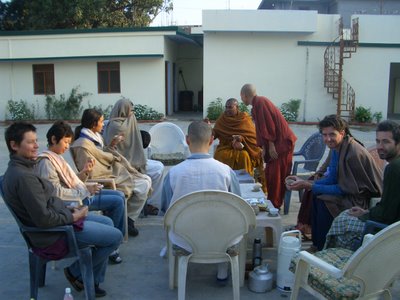
He also tells us a wonderful story about a Korean friend of his. He was from a v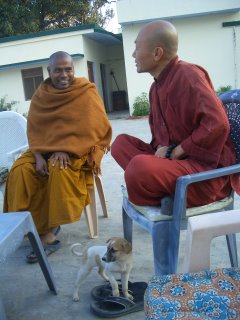 ery wealthy family, and fell in love with a girl from the lower class. They wanted to marry, but the boy's father would not grant permission. They knew they couldn't live without one another, and went to discuss their options. They talked about a double suicide, but determined that wouldn't work either-- how unhappy they would be then. So, somehow they decided that they would become monk and nun together. The man had just passed an extremely prestigious exam that would have assured him employment at the top level, but just the same, they had a kind of psuedo-wedding with their best friends, and after the ceremony, one went to the monastery, the other to the nunnery. This was 25 years ago, and the man says sometimes he has enormous feelings of gratitude for his father-- "if he had granted me my wish, I would have just married, like that. That's my life. But now, I have this Dhamma."
ery wealthy family, and fell in love with a girl from the lower class. They wanted to marry, but the boy's father would not grant permission. They knew they couldn't live without one another, and went to discuss their options. They talked about a double suicide, but determined that wouldn't work either-- how unhappy they would be then. So, somehow they decided that they would become monk and nun together. The man had just passed an extremely prestigious exam that would have assured him employment at the top level, but just the same, they had a kind of psuedo-wedding with their best friends, and after the ceremony, one went to the monastery, the other to the nunnery. This was 25 years ago, and the man says sometimes he has enormous feelings of gratitude for his father-- "if he had granted me my wish, I would have just married, like that. That's my life. But now, I have this Dhamma." The first day we go out, Alastair stays behind-- he has become a little sick now. We are told we must pay 100 rupees or two American dollars (I opt for the latter-- a savings of 15 rupees!) every time we want to enter. Not only can we not use the same ticket on consecutive days, we can't even go outside the park for a stroll. The Indian workers take our money without smiling and shove a ticket back at us. I can't help thinking of Burma, where, if you get a letter from the local Vipassana center saying you are visiting for Dhamma, not only are you exempt from any of the Buddhist sites, but you don't have to pay almost any other tourist charges as well-- the respect for Dhamma there goes to the highest level. All the same, it is still quite a pleasure to be in Jetavana-- a name that is so common in so many tales involving the Buddha.
The first day we go out, Alastair stays behind-- he has become a little sick now. We are told we must pay 100 rupees or two American dollars (I opt for the latter-- a savings of 15 rupees!) every time we want to enter. Not only can we not use the same ticket on consecutive days, we can't even go outside the park for a stroll. The Indian workers take our money without smiling and shove a ticket back at us. I can't help thinking of Burma, where, if you get a letter from the local Vipassana center saying you are visiting for Dhamma, not only are you exempt from any of the Buddhist sites, but you don't have to pay almost any other tourist charges as well-- the respect for Dhamma there goes to the highest level. All the same, it is still quite a pleasure to be in Jetavana-- a name that is so common in so many tales involving the Buddha. We see one great tree and Bhanteji tells us its story: when Buddha was leaving, the people wished for something to worship in his absence. He replied that they should be dhamma dipa, an island of Dhamma for themselves, and there was no need to worship any outer form. But they persisted, complaining they needed something to remember him by. So a seed was attained miraculously from Bohdgaya, and planted here, and it was this Bodhi tree given to the people. Many pilgrims and monks come to pay homage to it, and there are Tibetan prayer flags hanging high. We are told it is the very same tree. There is much like this on the course of the yatra we are told, that for a scientifically trained and oft-times skeptical Westerner can give form to mental confusion or doubt... can this really be the very same tree? Answered or no, though, it can be observed... there must be some sensation corresponding...
We see one great tree and Bhanteji tells us its story: when Buddha was leaving, the people wished for something to worship in his absence. He replied that they should be dhamma dipa, an island of Dhamma for themselves, and there was no need to worship any outer form. But they persisted, complaining they needed something to remember him by. So a seed was attained miraculously from Bohdgaya, and planted here, and it was this Bodhi tree given to the people. Many pilgrims and monks come to pay homage to it, and there are Tibetan prayer flags hanging high. We are told it is the very same tree. There is much like this on the course of the yatra we are told, that for a scientifically trained and oft-times skeptical Westerner can give form to mental confusion or doubt... can this really be the very same tree? Answered or no, though, it can be observed... there must be some sensation corresponding... There are many famous stupas and sites all around the park, but the most famous are the remains (or perhaps replica?) of a seven story building where Buddha used to stay. When we spot a break in the pilgrims and their chantings, we sneak into this and meditate for some time among the many offerings they have left-- incense, candles, gold dust, garlands, etc. (see photo). There is also a well that has existed since the time of the Buddha. Indians continually pump water out of it, their generosity going so far as to wish for and gladly accept tips for their service. As I try to wash my hands at one point, a mass of Tawainese pilgrims push past me to fill up big water bottles of the sacred liquid.
There are many famous stupas and sites all around the park, but the most famous are the remains (or perhaps replica?) of a seven story building where Buddha used to stay. When we spot a break in the pilgrims and their chantings, we sneak into this and meditate for some time among the many offerings they have left-- incense, candles, gold dust, garlands, etc. (see photo). There is also a well that has existed since the time of the Buddha. Indians continually pump water out of it, their generosity going so far as to wish for and gladly accept tips for their service. As I try to wash my hands at one point, a mass of Tawainese pilgrims push past me to fill up big water bottles of the sacred liquid.
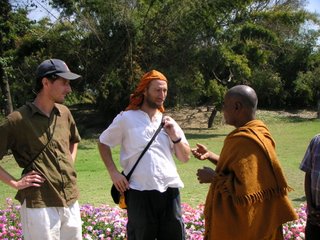 We have asked the head cook if we can take the leftovers from breakfast and eat them for lunch, but he frowns and says, "if my master (Sunim) learns about this, he will be very upset with me." So, every day he cooks Indian rice, dal, and subji, and workers walk into the park to deliver our lunch to us in metal tiffins. As on the previous days, Bhanteji continues meditating as we eat.
We have asked the head cook if we can take the leftovers from breakfast and eat them for lunch, but he frowns and says, "if my master (Sunim) learns about this, he will be very upset with me." So, every day he cooks Indian rice, dal, and subji, and workers walk into the park to deliver our lunch to us in metal tiffins. As on the previous days, Bhanteji continues meditating as we eat.

We get back well into night at the monastery, with little time for any bathing or showers. We are served more of that delicious tea (without milk) and all of us sit outside again with shawls, and usually in the evenings it is Bhanteji giving Dhamma Talks... really wonderful stories of Buddha, or discussing the subtle meaning of some of his sermons... always a fantastic treat to hear.
The next day, it is my turn to be sick and stay behind. I wake up feeling a little weak, and Kedaar passionately encourages me to come anyway or come as soon as I can. When I tell him I might go to the local Vipassana center instead, he reminds me of the benefit of Jetavana park. I walk into town, a town so removed from my world that you can't even find toilet paper, and make a ten minute call to my mom. Our trip will last one week longer than I last told her, and with no internet around, I want to inform her of our change. By the time I get back to the monastery, I am flaring with fever. It is extremely high for all of the day, but very confusing as well. At times I can't walk because I am too dizzy, although when I examine myself I feel the fever pushing off and numerous pleasant sensations beneath it. For several hours I feel an indescribable urge to mediatate and battle it out. I can't tell if it is physical or a sankhara, or elements of both. I sit in the elaborate Korean style hall and play U Ba Khin's chanting tape, wishing I could make it to sit in the strong Jetavana, but too weak to get there safely. I try to talk with the Korean monks, but although they seem to speak near fluent Indian English, they can barely understand a single word from my mouth. They are upset I refuse their Western medicine as I explain I am trying Chinese herbs. Then they suggest I eat ramen, and instruct their cook to make a bowl. I see Korean spices and noodles come out, and in an hour, eat one of the most delicous meals of authentic ramen I've ever had! (a monk may break the noon curfew on food due to illness) This does improve my health. I am feeling better the next day, though a little funny and nauseous most of the following week-- looking back on it now, much of it must have been sankhara somehow :) (a funny side note is how many goods here are from Korea-- just about everything you find at the Monastery, even things easily available, come directly from Korea) Somehow during the yatra I had had the feeling that once we stopped moving so much, there would be more down time. I was wrong. Not a moment, either in transit or stationary, was taken for granted. This was probably the hardest part for me. I really longed for time when I could just sit (without sitting, that is!), to take in where I was and what I was doing. I tried very hard to give myself over and entrust myself to Bhanteji's program, but it was difficult to be equanimous with the negativity or resistance that would come up-- intellectually it's all arising and passing, but so easy to overwhelm at times.
Somehow during the yatra I had had the feeling that once we stopped moving so much, there would be more down time. I was wrong. Not a moment, either in transit or stationary, was taken for granted. This was probably the hardest part for me. I really longed for time when I could just sit (without sitting, that is!), to take in where I was and what I was doing. I tried very hard to give myself over and entrust myself to Bhanteji's program, but it was difficult to be equanimous with the negativity or resistance that would come up-- intellectually it's all arising and passing, but so easy to overwhelm at times.
But as the days passed, and especially in Savatthi, this itself began to be an extremely eye-opening experience. I realized that Goenkaji's Vipassana is really aimed for householders who might like to do a bit of mental purification along the way-- the more the better, but the emphasis is definitely on applying it within the world. For these two weeks, I was exposed to the life of a full recluse, and it made me appreciate the monk and nun in ways I had never known before. I realized that devoting a life to sila and perhaps learning a few jhanas, and building up the paramis and devotion, was so beneficial-- I used to think without the panna from Vipassana it was useless. Not at all-- one could be so advanced that just a few minutes of Vipassana would find such ripe and receptive soil.
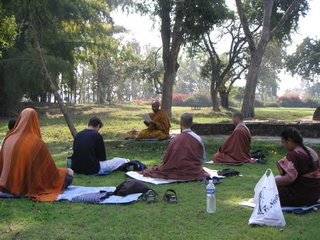 The phrase atapi sampajano satima took on much greater meaning. I realized I wanted a moment to rest, to have some time off, to enjoy a view or engage in a conversation, inspect a flower or watch a child watching me-- but over time, I began to remember experientially what I've learned so many times-- the fact that these sankharas are always burning, burning with these or with those characteristics, inciting this craving or that aversion, or supressed in ignorance. How is there time for anything else when one begins to see so clearly this burning nature? From a monk's point of view, anything that one does in the world that is not focused on eradicating these impurities is a product of Mara, an act of illusion and delusion. I felt so much peace when I arrived at the Korean monastery-- their attention to detail in the way they set the table or poured tea just contributed to the atmosphere feeling clean and proper. But Buddha went much deeper than this-- beyond this superficial calm to the raging agitations within, that don't leave us alone for even a minute. Even taking the time to write this or snap some photos along the way began to feel like I was rolling away in something... so here in Savatthi, the work was only slightly easier than before-- still falling into old patterns to express or supress the agitation, the burning-- or to take the middle path and observe... As hard as it was at time, I ended up being very influenced by the vigor and dedication that Bhanteji put forth himself and required of us-- yes, it makes a lot of sense...
The phrase atapi sampajano satima took on much greater meaning. I realized I wanted a moment to rest, to have some time off, to enjoy a view or engage in a conversation, inspect a flower or watch a child watching me-- but over time, I began to remember experientially what I've learned so many times-- the fact that these sankharas are always burning, burning with these or with those characteristics, inciting this craving or that aversion, or supressed in ignorance. How is there time for anything else when one begins to see so clearly this burning nature? From a monk's point of view, anything that one does in the world that is not focused on eradicating these impurities is a product of Mara, an act of illusion and delusion. I felt so much peace when I arrived at the Korean monastery-- their attention to detail in the way they set the table or poured tea just contributed to the atmosphere feeling clean and proper. But Buddha went much deeper than this-- beyond this superficial calm to the raging agitations within, that don't leave us alone for even a minute. Even taking the time to write this or snap some photos along the way began to feel like I was rolling away in something... so here in Savatthi, the work was only slightly easier than before-- still falling into old patterns to express or supress the agitation, the burning-- or to take the middle path and observe... As hard as it was at time, I ended up being very influenced by the vigor and dedication that Bhanteji put forth himself and required of us-- yes, it makes a lot of sense... We continued visiting Jetavana every day and paying the two dollar entry fee. We kept our rituals of morning breakfasts and tea, sitting until lunch arrived, then sitting some more and hearing some Dhamma talks, having some juice and chocolate in the afternoons, and going back after dark. Again, many dogs found their way to our group and laid down as we were meditating. One Kedaar recognized from last year. One day a dog approached us with a horrible skin disease. Half its face was missing and from rolling on the ground, various pebbles and dirt was sticking to the exposed bone and blood. It happily came to our group on several occasions, and a few of us nearly shook with repulsion. Once it fell down in front of Bhanteji. He said it must need metta, so he began chanting a metta sutta to the dog, who then promptly got up and pranced away. He used this dog for a following discourse, admonishing us for our eye sense door always craving pleasant images and hating and wishing to avoid unpleasant ones. Why not accept what comes in contact with the eye with equanimity? He went on to say that this dog must remind us the fragility and uncertainty of life. Anything may happen at any moment, and we must always be so aware and careful, for the mental state we are carrying at any one moment will have so much effect... "You must work hard," he said, "the next moment could bring death, with this curent state of mind and current defilement..."
We continued visiting Jetavana every day and paying the two dollar entry fee. We kept our rituals of morning breakfasts and tea, sitting until lunch arrived, then sitting some more and hearing some Dhamma talks, having some juice and chocolate in the afternoons, and going back after dark. Again, many dogs found their way to our group and laid down as we were meditating. One Kedaar recognized from last year. One day a dog approached us with a horrible skin disease. Half its face was missing and from rolling on the ground, various pebbles and dirt was sticking to the exposed bone and blood. It happily came to our group on several occasions, and a few of us nearly shook with repulsion. Once it fell down in front of Bhanteji. He said it must need metta, so he began chanting a metta sutta to the dog, who then promptly got up and pranced away. He used this dog for a following discourse, admonishing us for our eye sense door always craving pleasant images and hating and wishing to avoid unpleasant ones. Why not accept what comes in contact with the eye with equanimity? He went on to say that this dog must remind us the fragility and uncertainty of life. Anything may happen at any moment, and we must always be so aware and careful, for the mental state we are carrying at any one moment will have so much effect... "You must work hard," he said, "the next moment could bring death, with this curent state of mind and current defilement..."

 There were two tribes of monkeys in the park (one tribe used to sit outside on the fence as we approached in the morning-- see photo!). One that seemed fairly harmless, and another the kind that you can't make eye contact with at even ten feet away, or they might attack you. They had long tails that looked to be over two feet. Once this entire tribe decided to migrate past our group. As we sat meditating, we would hear the pounding of earth and feel a breeze past us-- monkeys always move one at a time, assess the situation, and the next one comes. These were quite big, and could do more than a little damage if they had half a mind to. It just so happened that 30 minutes beforehand, the curator of Jetavana had come over to us in curiousity-- rarely had he seen pilgrims meditating so ardently. What were we doing? Bhanteji spoke kindly to him, and upon sitting down, this man was given a Dhamma talk that included instruction in paramis, sila, samadhi, and panna. The monkeys came in the middle of this.
There were two tribes of monkeys in the park (one tribe used to sit outside on the fence as we approached in the morning-- see photo!). One that seemed fairly harmless, and another the kind that you can't make eye contact with at even ten feet away, or they might attack you. They had long tails that looked to be over two feet. Once this entire tribe decided to migrate past our group. As we sat meditating, we would hear the pounding of earth and feel a breeze past us-- monkeys always move one at a time, assess the situation, and the next one comes. These were quite big, and could do more than a little damage if they had half a mind to. It just so happened that 30 minutes beforehand, the curator of Jetavana had come over to us in curiousity-- rarely had he seen pilgrims meditating so ardently. What were we doing? Bhanteji spoke kindly to him, and upon sitting down, this man was given a Dhamma talk that included instruction in paramis, sila, samadhi, and panna. The monkeys came in the middle of this.
Occasionally a few of us meditators would open our eyes to assess the situation. How many monkeys, how close they were, what paths they were using. At times a meditator's body would be like the post that the monkeys would use to turn around during their sprint. We were just a few inches from them, as they passed our group and climbed the nearest tree. Some monkeys ran with baby monkeys clinging to their stomach or back. "Close your eyes!" Bhanteji shouted. "Do not give any importance to outside objects. Stay with sensations. If you have done nothing to harm these animals at any time, they have nothing against you." Great, I thought, so if I have harmed monkeys in some previous incarnation, I might get my payback with a surprise monkey hand gripping my neck or pulling my hair, to which Bhanteji would again instruct me to calmly observe sensations without paying attention to anything external! At one point he began to chant, and soon the monkeys left... he later explained this was a chant meant to get rid of dangerous animals. He also told us when one comes in contact with such animals, it is crucial to observe sensations immediately-- any past kamma with this animal will come up in gross form and leave instantly. (The other monkeys would actually run and hide behind a tree or rock when I merely pointed my camera at them!) The last thing we did before leaving Savatthi was to tour some local sights. We saw Anathapindika's house, as well as Mother Vishaka's nunnery, which was quite fascinating. We crawled through one tunnel that was so narrow we had to slither on our stomachs. The white cotton pants I had bought in Bombay now had a new stain to add to their effort-- just a few minutes later they tore as we caught a lift back on the Sri Lankan bus-- they became a symbol of the trip for me! (As with the umbrella I borrowed from Kedaar, which was torn, broken, twisted inside out from wind, stained with dirt, and forgotten...)
The last thing we did before leaving Savatthi was to tour some local sights. We saw Anathapindika's house, as well as Mother Vishaka's nunnery, which was quite fascinating. We crawled through one tunnel that was so narrow we had to slither on our stomachs. The white cotton pants I had bought in Bombay now had a new stain to add to their effort-- just a few minutes later they tore as we caught a lift back on the Sri Lankan bus-- they became a symbol of the trip for me! (As with the umbrella I borrowed from Kedaar, which was torn, broken, twisted inside out from wind, stained with dirt, and forgotten...) A Hindu sadhu (recluse) was living in a small hut and was now a fire worshipper at the old site of the nunnery. An original Ashokan stupa had been painted and oranamented and was now used as a Shiva worship object. We meditated outside it, and then Kedaar approached the sadhu and engaged in a long conversation asking if we may be able to buy the sacred land and turn it into a monastic dwelling for Bhanteji. At one point he took out his bugle and played some strange off-key notes, to which his dog howled in unharmony.
A Hindu sadhu (recluse) was living in a small hut and was now a fire worshipper at the old site of the nunnery. An original Ashokan stupa had been painted and oranamented and was now used as a Shiva worship object. We meditated outside it, and then Kedaar approached the sadhu and engaged in a long conversation asking if we may be able to buy the sacred land and turn it into a monastic dwelling for Bhanteji. At one point he took out his bugle and played some strange off-key notes, to which his dog howled in unharmony.

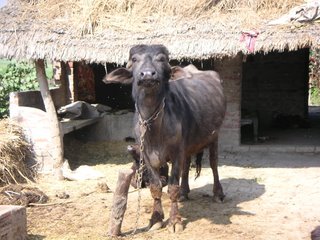 The young Indian monks from the Korean monastery found us, delivered our food in the tiffins, and we ate at their friends' home in the middle of a village that looked like it could have changed little from 500 years back. We walked past many water buffalo that stared at us as intensely as the Indians themselves (see photo!). There were more flies here than I had ever seen in my entire life. Several of the Indians waved huge fans until we finished so we didn't have several dozen insects on us and our plates. After we ate, Bhanteji gave the large family a Dhamma talk, and asking them to take refuge in Triple Gem, begin instructing them in Anapana. You can see the photo below...
The young Indian monks from the Korean monastery found us, delivered our food in the tiffins, and we ate at their friends' home in the middle of a village that looked like it could have changed little from 500 years back. We walked past many water buffalo that stared at us as intensely as the Indians themselves (see photo!). There were more flies here than I had ever seen in my entire life. Several of the Indians waved huge fans until we finished so we didn't have several dozen insects on us and our plates. After we ate, Bhanteji gave the large family a Dhamma talk, and asking them to take refuge in Triple Gem, begin instructing them in Anapana. You can see the photo below...
Thus our trip came to a close, we had some very long metta sessions and made our way to the night train heading another 30 hours to Igatpuri. Free from our 8 precepts, craving overtook us and we bought an unbelievable and rather embarrassing amount of snack food, of which we ultimately ate very little of and felt sick for even this amount.
For photos of Savatthi, go here!
 Here are some neat photos of one of the new (and enormous!) Thai monasteries now being constructed....
Here are some neat photos of one of the new (and enormous!) Thai monasteries now being constructed....

And a last shot of the Sri Lankans!
No comments:
Post a Comment